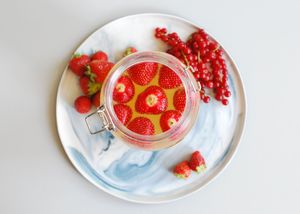To keep my gut nourished with good bacteria, I try to consume something fermented each day. Usually I tend towards sauerkraut, kimchi and pickles, all of which I make at home. I'm still working on a coconut yoghurt that's better than, or at least as good as, the stuff I can get from my local organic shop, but the same place also sells a de-li-ci-ous water kefir, which is basically like a probiotic soda. My boyfriend and I call it 'the most refreshing drink in the world'. Lemon and fig flavour, it's sour, fizzy and oh-so thirst-quenching.
I figured I'd give homemade water kefir a go for a few reasons: I can define the flavour by what fruit's in season, it's cheaper than buying the store-bought stuff, and it saves on packaging.
The process involves a two-part fermentation and an extra day at the end to make it fizzy, but technically you can drink the kefir after the first or second stage if you like. The second fermentation is where things get tasty, as you add in seasonal fruits for flavour. The image shows a mixture of strawberries and red currants*, but I've tried everything from apples and pears to mangoes and oranges. Ginger is a great addition too, and apparently kefir loves it.
Before you worry about the sugar involved in this recipe, there are only residual amounts of the sweet stuff left in the resulting drink as most of it is gobbled up in the fermentation process.
When cared for properly, the grains can be used indefinitely and will multiply. Mine breed like crazy and I've already given batches to a few friends along the way. I also keep a jar of extras in the fridge, which I add into smoothies (around a tablespoon per smoothie).
I've included two recipes below: one simple, one a bit more involved. Both work, but after much reading and many research batches, I've learned that apparently the grains benefit from a few extra minerals, hence the additional ingredients.
*Full disclosure: the strawberry-and-red currant combo makes for a pretty picture but wasn't my favourite. Too much sweetness from the strawberries, not enough sourness from the currants. My instinct tells me if you're using thick-skinned fruits, mash or muddle them a little instead of adding them whole. I'll give it a try sometime to find out.
